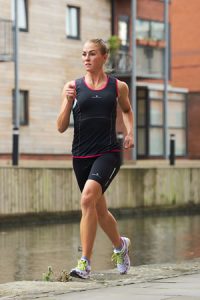 Most runners know that good posture is important while running.
Most runners know that good posture is important while running.
The more you drop your head forwards and the more you slump your shoulders forwards the harder the body’s muscles have to work as your centre of gravity shifts forwards, this can lead to fatigue earlier than expected during a run and then it’s a struggle to the finish.
The problem however possibly lies in your everyday postural choices rather than the running itself (although this can also be a contributing factor). Everyday activities such as using a computer, driving, and sitting on the sofa can lead to a gradual weakening of the scapular stabilisers, retractors and depressors (the muscles that keep the shoulders back and down in a good position).
Posture
Put simply, our posture is an end product of the way our muscles hold onto our bones and the way those muscles move our joints. Where the bones are located in relation to each other is effected by the forces being imparted across where two or more bones form a joint. Poor posture can lead to pain or at worst injury.
We often hear phrases such as “my rounded shoulders are genetic”, “my flat feet are genetic”, however, while you may be genetically more susceptible to these two common misalignments they are changeable i.e. we can inhibit (calm down) and lengthen certain muscles and activate (fire-up) and integrate (get the muscle working as part of a chain of muscles) other muscles to make a change to the joint movement and alter the position of the bones.
What to do if you think you have poor posture
Two of the main postural syndromes, Upper Crossed Syndrome and Lower Crossed Syndrome are commonplace in our society nowadays. Upper crossed syndrome is defined by a rounding of the shoulders and a forward head position while lower crossed syndrome is characterised by a forward-tilted pelvis (the bottom sticks out) and a rounded stomach
To find out more about the syndromes the following website is very helpful; http://www.jandacrossedsyndromes.com
There’s a combination of foam rolling, stretches and exercises you can do to alter your posture depending upon which of the two syndromes you may have (or both). However, if you’re not practicing good posture then you will always be feeding the animal.
Maintaining Good Posture
While working/driving/eating take your mum’s advice and try to do the following things;
Sit up straight with your shoulders back and down and your head looking straight ahead (eyes level)
Keep your chin pulled back (try not to push your head forwards)
Try not to reach far away from your body with your arms as this could round your shoulders.
When seated, your hips should be slightly higher than your knees
Your feet should be flat on the ground in front of you.
If you have an ergonomic chair your back should follow the contours of the chair (if the chair has been set up correctly, it should provide support in the lower and mid-back region).
If you’re sat down at home try setting a reminder on your phone for every five minutes, when it goes off, sit up, practice this until you start catching yourself with good posture, eventually it will become habit. If you’re at work, try sticking multicoloured sticky spots on the items you use on a regular basis, every time you see one sit up (move the spots around from object to object so you don’t begin to ignore them).
While running;
Keep your shoulders relaxed, back and down
Keep your head level, looking forwards
When you need to look where you are running try to look down with your eyes as opposed to moving your whole head down.
Try not to swing your arms across your body as this will generate rotation in the shoulders and potentially round your shoulders.
Arms that swing across your body can also create rotation in the legs and cause something called crossover gait which has been linked to various issues, including IT Band syndrome.
Whether you’re a casual runner or an elite runner, good posture can really benefit you, either making it a little easier to keep going or preventing power leaks that are costing you seconds in pursuit of your personal best.
Try to remind yourself to check your posture throughout your run, maybe at each lamppost or tree or perhaps every time you glance at your heart-rate tracker. Or alternatively write a blog entry about posture, it works a treat!
Enjoy your running
Matt Jeffery
